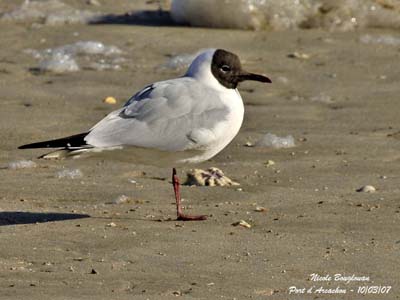
Black-headed Gull
Chroicocephalus ridibundus
Charadriiforme Order – Laridae Family
BIOMETRICS :
Length : 37-43 cm
Wingspan : 94-110 cm
Weight : 195-325 g
LONGEVITY: Up to 30 years
DESCRIPTION:
Black-headed Gull is a widespread species, very noisy and opportunist feeder.

Adult in breeding plumage has dark chocolate-brown frontal hood including head, chin and throat. According to the attitude, this hood seems to vary in size. The neck is white.
The upperparts, including back, upperwing coverts, secondary and inner primary feathers are grey. The secondaries are tipped white. The outer primaries are white with black tips and edges. Tail is white.
The underparts are white (or with pink wash in Norway populations).
Eyes are dark brown, with two white crescents. Bill, legs and feet are deep red.
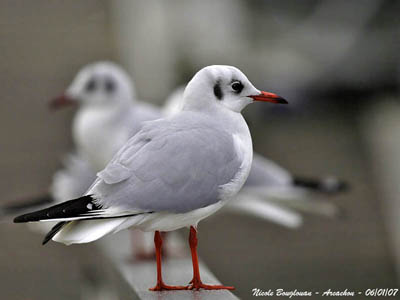
Adult in non-breeding plumage has white head with blackish spots on the ear-coverts and two dusky blurred bands on the crown. Reddish bill is black-tipped.
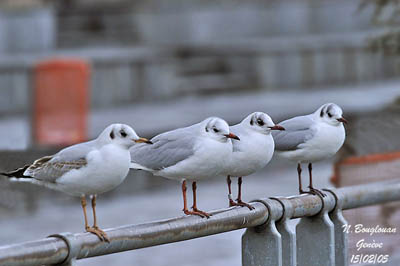
Both sexes are similar.
Juvenile has buff to darker brown markings on the upperparts and upperwing coverts. Tail shows black terminal band. Bare parts are duller.
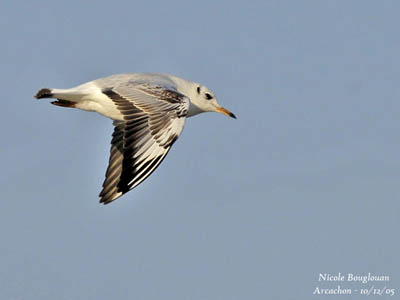
1st winter resembles adult in basic plumage, but wings, tail, bill and legs are as in juvenile.
Both have yellow orange bill with black tip.
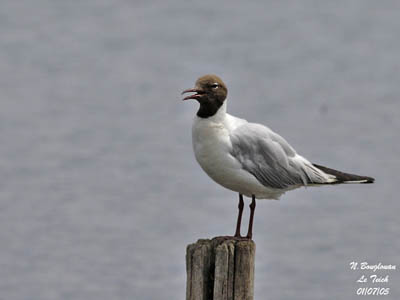
VOICE:
Black-headed Gull is a noisy bird. The usual call is a screaming “karr” or “kreeay”, both high-pitched. We can also hear a sharp “kek-kek” when the bird is feeding.
HABITAT:
Black-headed Gull frequents marshes, fresh and brackish ponds and lakes for breeding, but some populations may nest is relatively dry sites such as sand dunes and beaches.
All year round, this species frequents a wide variety of habitats such as shallow water (coastal or inland), rivers and estuaries. It may be found inland, at fairly low elevation, and within towns and cities if water is available.
This species lives from temperate areas to the boreal forest edges of Palaearctic.
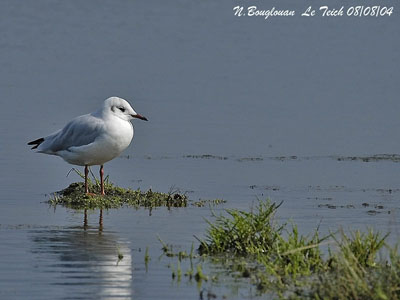
RANGE:
Black-headed Gull breeds in most parts of Europe and Asia, but also in coastal eastern Canada.
The most part of populations are migratory and move southwards in winter. But other populations of the westernmost of Europe are resident or dispersive.
BEHAVIOUR:
Black-headed Gull feeds on varied food items such as aquatic and terrestrial insects, earthworms, marine invertebrates, some fish, grains and berries.
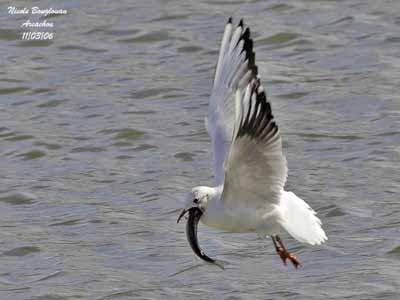
This bird feeds by swimming and taking items from the surface, or by dipping the head under the surface. It also walks along the coasts, in mudflats, and probes for aquatic invertebrates. It may sometimes use the foot-stirring. It follows the fishing boats for offal.

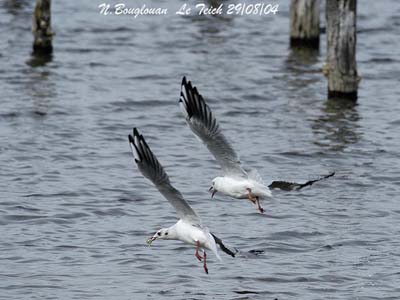
Black-headed Gull sometimes engages in piracy from other seabirds, and may take eggs at terns’ colonies.
This species may feed alone or in noisy flocks.
Black-headed Gull is territorial as numerous gulls’ species. The size of the territory depends on the size of the species and the number of pairs.
During disputes, the dark hood is aggressive feature, whereas the white nape means the submission.
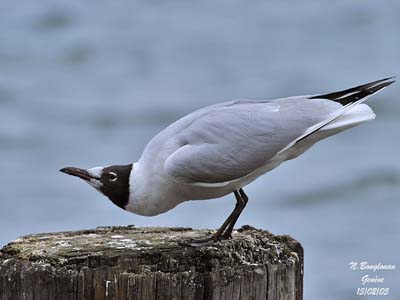
Other displays show the bird in varied attitudes. The oblique display is aggressive with erect posture; the ahead display with held neck, and horizontal head and bill; the obstructive display with the bird bowing towards the ground, bill downwards, while the bird utters weak calls in rapid series of short notes.
They are very vocal at all phases of the breeding cycle. They call in flight, when landing, on the ground…
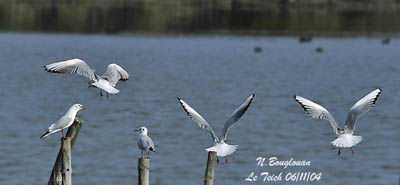
The typical “long-call” is given on the ground or in flight, and frequently followed by “head-tosses” with the head on the back.
Displays are performed during hours when the pair is formed, and we can also observe courtship feeding.
Nest building takes part in pair formation once the nest-site is chosen by both mates. The territorial defence is strong and the pair spends most of the day on its territory.
FLIGHT:
Black-headed Gull performs quick and active flight. It also may soar and glide, and it catches flying insects while flying.

REPRODUCTION:
Breeding season starts in late March, and egg-laying occurs in late April and May.
Black-headed Gull nests in colonies of several tens of pairs (sometimes more). Nests are built about one metre apart from each other, and they can often touch.
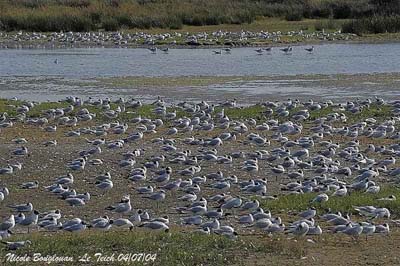
Colony is usually established near vegetation, sometimes a pile of dead plants.
Female lays 1 to 3 eggs. Incubation lasts about 22 to 26 days, shared by both parents.
Chicks are precocial. They are fed by both adults. Young remain near the nest-site until they fledge, about 35 days after hatching.
This species produces only one brood per year.
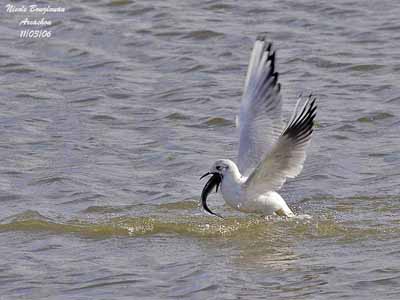
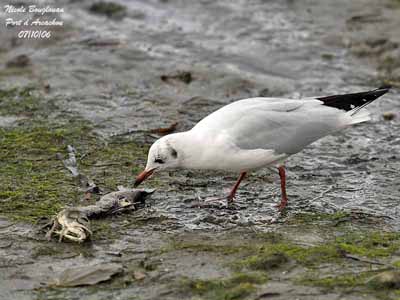
DIET:
Black-headed Gull feeds on both aquatic and terrestrial insects and invertebrates, some fish, variety of grains and berries. It takes offal from fishing boats and refuse inland. It may steal food from other gulls by harassment.
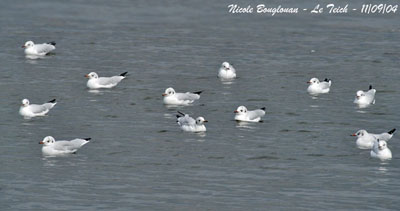
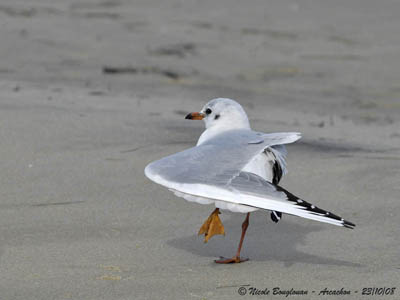
PROTECTION/ THREATS/ STATUS:
Populations of Black-headed Gulls are important. Some declines and increases are observed according to the range, but this species is not threatened at this moment.
Fr: Mouette rieuse
All : Lachmöwe
Esp : Gaviota Reidora
Ital : Gabbiano comune
Nd : Kokmeeuw
Russe : Озерная чайка
Sd: Skrattmås
Photographs and text by Nicole Bouglouan
Sources:
HANDBOOK OF THE BIRDS OF THE WORLD Volume 3 by Josep del Hoyo-Andrew Elliott-Jordi Sargatal - Lynx Edicions - ISBN : 8487334202
THE HANDBOOK OF BIRD IDENTIFICATION FOR EUROPE AND THE WESTERN PALEARCTIC by Mark Beaman, Steve Madge - C.Helm - ISBN: 0713639601
THE COMPLETE BOOK OF BRITISH BIRDS – Written by “Royal Society for the Protection of Birds” experts - Préface de Magnus Magnusson - Michael Cady- Rob Hume Editors - ISBN: 0749509112
The Longevity List (Roland Staav)
Wikipedia (Wikipedia, The Free Encyclopedia)